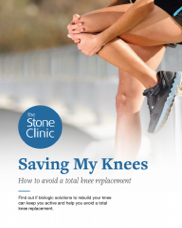Why fix or replace a meniscus?
My journey toward becoming an orthopedic surgeon began with a serious knee injury I suffered when playing soccer in college.
My meniscus cartilage, the shock absorber in the knee, was torn and the surgeon just took it out and threw it away. While I admired the surgeon who removed it, I was frustrated by the primitive techniques. Surely there had to be a better way? From that time on, I have been thinking about how to repair, regrow or replace this vital piece of cartilage.
 The meniscus is a fibrous piece of cartilage that sits between the femur (thigh bone) and the tibia (shin bone). There is a medial meniscus, meaning the inside one, and a lateral meniscus, an outside one. The meniscus plays a crucial role in joint stability and lubrication. It is simultaneously soft, smooth and durable, providing a gliding surface between the articular cartilage in the knee that is five times smoother than ice on ice. It is also capable of withstanding tremendous forces, absorbing the shock caused by the motion of up to 3 million steps per year at up to five times a person's body weight.
The meniscus is a fibrous piece of cartilage that sits between the femur (thigh bone) and the tibia (shin bone). There is a medial meniscus, meaning the inside one, and a lateral meniscus, an outside one. The meniscus plays a crucial role in joint stability and lubrication. It is simultaneously soft, smooth and durable, providing a gliding surface between the articular cartilage in the knee that is five times smoother than ice on ice. It is also capable of withstanding tremendous forces, absorbing the shock caused by the motion of up to 3 million steps per year at up to five times a person's body weight.
People injure the meniscus in sports and twisting activities, such as planting a foot on a soccer field and then being hit from the side, or they injure it in simple activities, such as getting out of the car, placing the foot on the ground, stepping up and twisting on the knee, and feeling a sudden catch or pop. Once torn, the fibrous shock absorbers produce a rough surface inside the knee, which causes catching, locking, buckling, pain or any combination of the above symptoms inside the knee joint.
Most injuries to the meniscus are tears. If the tear is in a clear, clean pattern, it can often be repaired with sutures, sometimes adding growth factors and clot materials to augment healing. If it is torn in a complex or degenerative pattern, the damaged tissue is often trimmed away. Advanced repair techniques bring new blood supply into damaged tissue so a larger area of the meniscus can be repaired than previously thought. However, if the meniscus cartilage is significantly damaged, the tissue will need to be removed.
Losing a meniscus is tough on the body. Without a meniscus, the covering of each of the bones, called the articular cartilage, rub up against one another, which leads to pain. Eventually, as I can personally testify, it leads to arthritis, the wearing away of the articular cartilage at the ends of the bones.
My patients often ask me the very same question I once asked my surgeon: "Isn't there a shock absorber you can put back into the knee joint to replace the meniscus and to cushion the bones?"
Thankfully, unlike the answer I heard all those years ago, today I am happy to answer my patients with "Yes."
Over the past 20 years, the technique of replacing the meniscus while minimally disrupting other joint tissues has developed into an outpatient arthroscopic procedure: A meniscus allograft, a donor meniscus cartilage matched to a patient's height and weight, is used. The allograft meniscus is accurately placed into the knee and carefully secured with sutures. The patients then follow a specific rehabilitation protocol to get them back to full fitness.
Traditionally, it was thought that you could not replace the meniscus if the knee had already become arthritic. Our data show this is not true. When the opposing surfaces are arthritic, they can be treated with a paste-grafting procedure to restore the articular cartilage. Over the past 20 years, our studies of the survival of meniscus cartilage in arthritic joints have seen superb results, with 80 percent of patients reporting reduced pain and improved function over the long term.
Living with a damaged or missing meniscus is a recipe for arthritis. Fixing tears early or replacing the meniscus may help you avoid this fate. Repairing the arthritic cartilage and replacing the missing meniscus can keep you biologic and help you delay or avoid an artificial knee replacement. In our view, biology trumps bionics any day of the week.


